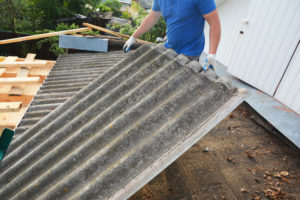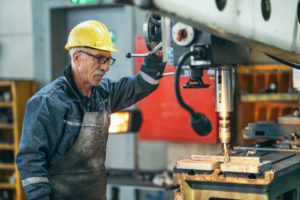Occupational Asbestos Exposure and Lung Cancer
Millions of workers were exposed to asbestos, a cancer-causing substance, for much of the 20th century. Those exposed could develop lung cancer and other deadly diseases later in life. Thankfully, you can pursue justice and compensation if you got sick from occupational asbestos exposure.
Which Jobs Have a High Risk of Occupational Asbestos Exposure?
 Many jobs put workers at risk of occupational asbestos exposure and lung cancer. Industries across the world used a highly durable material called asbestos prior to the early 1980s. The risks weren’t known since makers of asbestos-based products hid the facts to make money.
Many jobs put workers at risk of occupational asbestos exposure and lung cancer. Industries across the world used a highly durable material called asbestos prior to the early 1980s. The risks weren’t known since makers of asbestos-based products hid the facts to make money.
Over 27 million workers were exposed to asbestos between 1940 and 1979, according to the Agency for Toxic Substances and Disease Registry (ATSDR).
You could be at risk of asbestos lung cancer if you worked as a:
- Boilermaker
- Construction worker
- Electrician
- Factory worker
- Firefighter
- Mechanic
- Plumber
- Shipyard worker
- U.S. service member
Asbestos lung cancer is very aggressive, but aid is available. You may be able to get financial compensation and justice if you develop lung cancer or other asbestos diseases.
Get a free case review right now to get started. We may be able to help you even if you aren’t sure your illness is linked to occupational asbestos exposure.
- Access Financial Aid and Justice
- Learn About Your Options
- Contact Us for Free

List of High-Risk Asbestos Lung Cancer Occupations
Boilermakers
Boilermakers build and repair boilers. Boilers were often built with asbestos-containing materials before the 1980s.
Boilermakers relied on asbestos to keep boilers operating under high pressure and temperatures, since asbestos was heat-resistant. Boilermakers often worked in cramped spaces, so they could easily inhale asbestos fibers that entered the air during repairs or installations.
“Past studies of boilermakers have shown increases in mortality from lung cancer and asbestosis and radiographic changes consistent with asbestos exposure.”
— American Journal of Industrial Medicine
Boilermakers that served in the U.S. Navy before the 1980s had “highly probable” exposure to asbestos, according to the U.S. Department of Veterans Affairs (VA).
Construction Workers
Construction workers often handled asbestos-based building materials on a daily basis between the 1930s and 1980s. Companies used asbestos in a wide range of products used to build homes, offices, and many other structures.
Construction workers could have been exposed to asbestos from:
- Caulking
- Ceiling and floor tiles
- Drywall
- Insulation
- Paint
- Roofing materials
- Wallboard
The list above is just a few of the construction materials that contained asbestos. Working with any asbestos-containing materials could send asbestos dust flying. Workers that inhaled the airborne asbestos could develop lung cancer or other diseases later in life.
Those who work in the modern-day construction industry could also be at risk, as many older buildings still have asbestos inside even today.
Electricians
Electricians worked with asbestos since it was heat-resistant and reduced the risk of electrical fires.
Asbestos was used in electrical wire insulation, motor controllers, circuit boards, and other equipment for decades. Electricians might’ve also disturbed asbestos found in buildings (such as insulation) as they removed or installed electrical components.
Today, electricians may need to note any possible products that could contain asbestos and ensure they will either be contained or removed before they start working.
Factory Workers


In 1989, the town Cloquet, Minnesota had a lung cancer rate 36% higher than the general population. Many of the town’s men worked in a factory owned by Conwed, a company that used asbestos to make ceiling tile and mineral board.
The factory workers used bags of asbestos on the job, which coated their clothing and the cars they drove home in. A former employee stated he didn’t believe “anybody could have worked in worse conditions.”
Sadly, factory workers around the country were put in danger from asbestos for decades.
Firefighters
Firefighters could have faced occupational asbestos exposure if a building made with asbestos-containing products caught on fire. The asbestos fibers could then get picked up by the smoke and be inhaled by the firefighters.
Firefighters may have been exposed to asbestos in other ways, too. Fire engines and stations may have been built with asbestos-containing products prior to the 1980s. Reports of decades-old fire stations containing asbestos have made headlines as recently as 2022.
The Centers for Disease Control and Prevention (CDC) notes that firefighters are twice as likely to develop malignant mesothelioma, an asbestos-caused cancer that affects the linings of major organs.
Get help for asbestos-related diseases like lung cancer and mesothelioma. Call (877) 446-5767 right now.
Mechanics
Many plane and auto mechanics likely suffered from occupational asbestos exposure on a daily basis before the early 1980s. Asbestos was used in plane and car parts since it reduced friction and heat.
Asbestos-containing parts included:
- Brakes and brake pads
- Clutch components
- Engine gaskets
- Hood liners
- Insulation
- Wires
Mechanics at the greatest risk worked directly with asbestos-based products for long spans of their career.
For example, a man died of asbestos-related lung cancer in his early 50s after serving as a mechanic for over 30 years. He often worked with asbestos-containing brake pads. He also brought asbestos-contaminated clothing home with him, causing his son to develop pleural mesothelioma decades later.
The Occupational Safety and Health Administration (OSHA) has regulations in place to keep modern-day mechanics safe from occupational asbestos exposure since older vehicles may still have asbestos parts.
Plumbers


Plumbers may be at risk of occupational asbestos exposure even in the present day if they have to work on older structures that still contain asbestos.
Shipyard Workers
Shipyards were some of the most dangerous work sites when it came to occupational asbestos exposure. One-third of all mesothelioma cases today involve U.S. Navy personnel or shipyard workers.
Shipyard workers had to install asbestos-containing ship products like piping, insulation, turbines, and gaskets, and repair or remove them if they wore out.
“The people with the heaviest exposure are those who worked in asbestos industries, such as shipbuilding and insulation. Many of these people recall working in thick clouds of asbestos dust, day after day.”
— The American Cancer Society
A lung cancer diagnosis after working in shipyards can be devastating, but help is available. Chat with our team if you worked around asbestos and now have lung cancer. Pursue financial compensation and justice.
U.S. Veterans
Like shipyard workers, U.S. veterans are also at an increased risk of lung cancer and asbestos-related illnesses. All branches of the U.S. military heavily relied on asbestos between the 1930s and the early 1980s.
Asbestos was used in U.S. military:
- Bases and buildings
- Construction products
- Equipment
- Ships
- Vehicles (cars, trucks, and planes)
The U.S. Navy used more asbestos than any other military branch. Miles of asbestos-containing insulations, pipes, and cables were used throughout its vessels. Boilers, turbines, and thousands of gaskets aboard these ships used asbestos too.
The highest-risk veterans worked with asbestos as part of their Military Occupational Specialty (MOS). The VA lists 50 military jobs where occupational asbestos exposure was “probable” or “highly probable.”
Thankfully, veterans can receive financial aid to cover expenses after a lung cancer diagnosis. VA benefits can also help veterans with lung cancer and other asbestos-related diseases, as long as there’s proof the veteran was exposed to asbestos while they served.
Our team is standing by to help U.S. veterans and anyone else who’s developed asbestos lung cancer or other related diseases. Start the process with a free case review.
- Access Financial Aid and Justice
- Learn About Your Options
- Contact Us for Free



Secondhand Exposure
The health risks of occupational asbestos exposure weren’t just limited to workers. Asbestos fibers and dust could stick to workers’ hair and clothing. The workers could then bring the fibers home with them and expose their loved ones.
For example, Julie developed mesothelioma in her mid-30s due to secondhand asbestos exposure. Her father worked as an electrician for 40 years and died of asbestos lung cancer just a year before Julie’s own diagnosis.
“My father would come home from work, and I’d run up and hug him. He was covered in dust from a worksite. We didn’t know that that included asbestos dust. When my mother washed his clothes in the laundry room that doubled as my playroom and shook out the dust, she had no idea she was spreading asbestos fibers throughout our house.”
— Julie, Mesothelioma Patient
Thankfully, Julie was able to receive financial assistance and afford treatment by working with a mesothelioma law firm. Julie is still alive today thanks to the treatments she received.
Other Occupations Exposed to Asbestos
The occupations listed above were only a few that put workers at risk of lung cancer and other asbestos-related diseases.
Other high-risk asbestos occupations included:
- Asbestos mining: Asbestos is a naturally found mineral, so it needs to be mined before it can be used. Mining released asbestos fibers into the air and put anyone nearby at risk.
- Carpentry: Like construction workers, carpenters may have needed to remove old asbestos-based products or install new ones in buildings. They could have been exposed to asbestos joint compound, insulation, plaster, and more.
- Metal work: Metal workers may have been exposed to asbestos that was used to make metal beams fireproof. They could have also come in contact with asbestos insulation or spray-on asbestos that was used to strengthen metal.
- Pipefitting: Cement pipes were often made with asbestos to make them more durable, which put pipefitters who needed to install or repair them in harm’s way. WaterWorld Magazine estimated that nearly 600,000 asbestos-containing water pipes were still in use in the U.S. and Canada as of 2019.
Work Sites With a High Risk of Occupational Asbestos Exposure
Work sites around the world put innocent people in danger of occupational asbestos exposure.
- Chemical plants
- Construction sites
- Factories
- Mines
- Oil refineries
- Older buildings with asbestos-based products
- Power plants
- Shipyards
Our team can see if your cancer diagnosis was linked to occupational asbestos exposure with our database of high-risk asbestos work sites.
Help for Those With Lung Cancer From Occupational Exposure
The use of asbestos has put millions of workers and their family members at risk of lung cancer, mesothelioma, asbestosis, and other asbestos-related diseases. But help is available so those affected can pursue justice and financial compensation.
Major companies that made and sold asbestos-based products were aware of the health effects, but hid them from the general public for decades. Millions had already been exposed by the time the dangers were revealed in the late 1970s. Those with asbestos-related diseases may be able to take legal action to get compensation from these companies.
Compensation for asbestos-related diseases can pay for:
- Household bills
- Lost wages
- Medical treatments
- Other expenses
Our team can help you get compensation and justice if you have lung cancer or another asbestos-related disease. We can also see if an illness you have (like lung cancer) is related to occupational asbestos exposure. Call (877) 446-5767 now to get started.
FAQs About Occupational Asbestos Exposure & Lung Cancer
How long do you have to be exposed to asbestos to be at risk of lung cancer?
There is no safe level of asbestos exposure. Even low levels of exposure can lead to lung cancer or other asbestos-related diseases later in life.
However, those who worked around asbestos on a regular basis for years or decades at their job sites are at greater risk than the general population.
What is occupational asbestos exposure associated with?
Occupational asbestos exposure is linked to a higher risk of cancers like mesothelioma and lung cancer, as well as noncancerous illnesses like asbestosis.
However, there’s no guarantee that you will develop lung cancer or any asbestos-related disease if you were exposed.
Am I at risk of getting sick if I worked around asbestos decades ago?
Yes. Asbestos-related diseases have a long latency period (time between exposure and symptoms). It takes 10-50 years before lung cancer, mesothelioma, or other diseases appear after you were exposed to asbestos.
Most mesothelioma patients are diagnosed in their 70s, long after they’ve retired.
Is occupational asbestos exposure still a threat today?
Yes. Those who work around older buildings and structures could be exposed to asbestos even in the present day.
The National Institute for Occupational Safety and Health (NIOSH) notes that many older homes and commercial buildings have asbestos intact, which could put anyone in danger if disturbed.
If you believe asbestos is present on your work site, don’t go near it and call an abatement (removal) specialist.
Can occupational asbestos-related lung cancer be prevented?
There’s no way to completely prevent asbestos-related lung cancer or other diseases if you were already exposed to asbestos at your job. That said, there are some steps you can take to reduce your risk factors.
First, make sure to tell your doctor about your occupational asbestos exposure. This will help them to be on the lookout for possible signs of asbestos-related diseases later in your life.
You might also want to get regular lung cancer screenings. A screening can catch lung cancer before it spreads.
Finally, quitting smoking could significantly reduce your risk. Smoking is the biggest risk factor for lung cancer, according to the Centers for Disease Control and Prevention (CDC). Further, the Environmental Protection Agency (EPA) notes that combined asbestos exposure and smoking greatly increases the risk of lung cancer.

